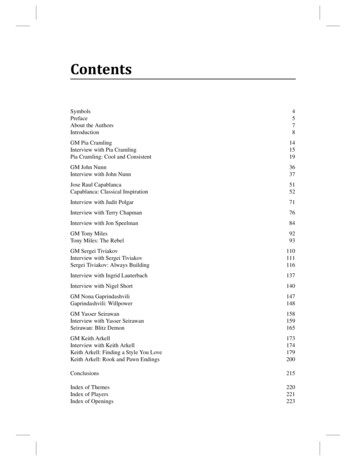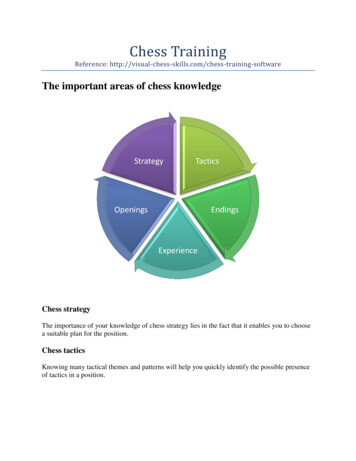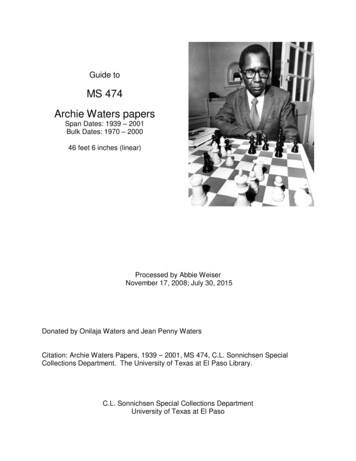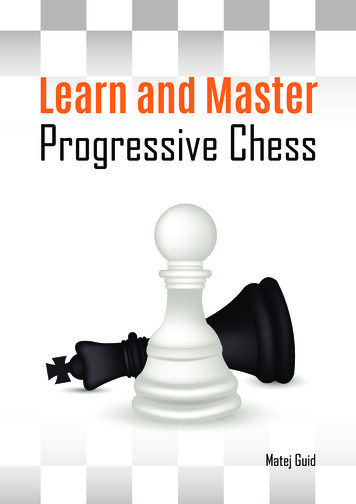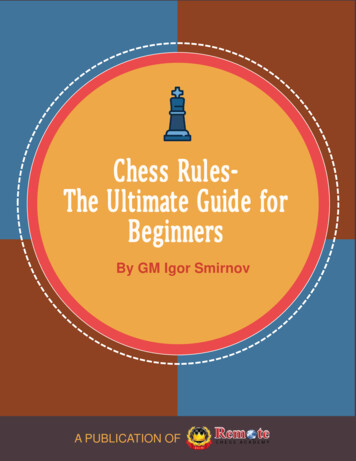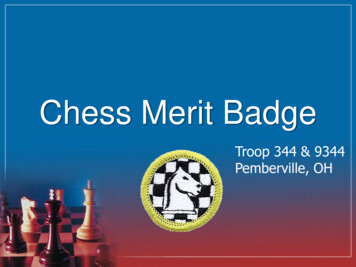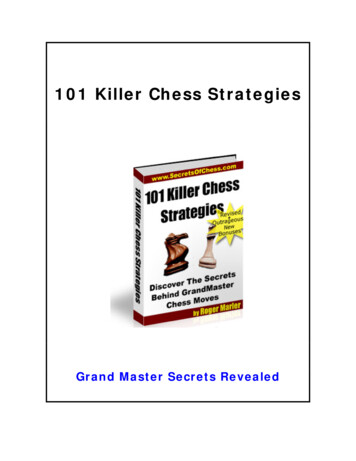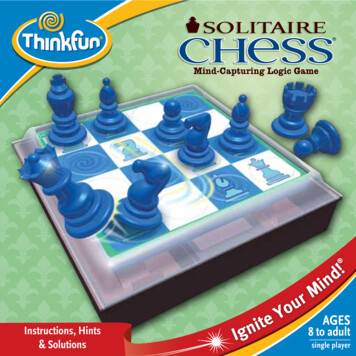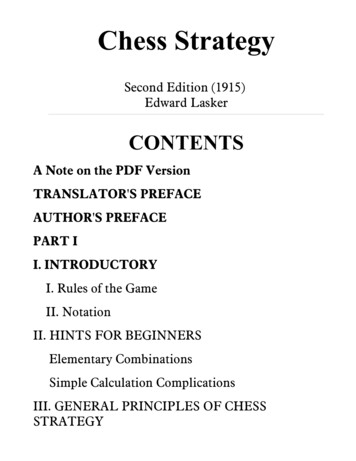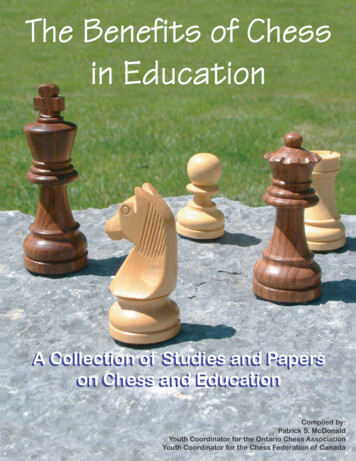
Transcription
The Benefits of Chessin EducationA CollectionCollection ofof StudiesStudies andand PapersPapersAon ChessChess andand EducationEducationonCompiled by:Patrick S. McDonaldYouth Coordinator for the Ontario Chess AssociationYouth Coordinator for the Chess Federation of Canada
2
Table of ContentsChess in Education Research Summary5Dr. Robert Ferguson compiles a series of research papers and summarizes them in one concise paperWhy Offer Chess in Schools?9Chessmaster Jerry Meyers offers his views along with some test results and conclusions from those tests.Some Thoughts on the Educational Merits of the Game Chess11Phil Shapiro discusses some of the school-sponsored chess projects underway in the US.Chess Makes Kids Smart15Anne Graham dicusses anecdotes showing many of the benefits of kids learning chess.Chess Improves Academic Performance19An article derived primarily from: “New York City Schools Chess Program” by Christine Palm - 1990Teachers Guide: Research and Benefits of Chess21Another summary of many studies by Dr. Robert C. Ferguson Including many resources for moreinformation listed.Scientific Proof: Chess Improves Reading Scores35Beverly Byrne highlights a New York City Study.37Chess Makes Kids SmarterDr. Gerard Dullea reviews studies done over the years.The Case for Chess as a Tool to Develop Our Children’s Minds39Dr. Peter Dauvergne of the University of Sydney surveys educational and psychological studies to examinethe benefits for children of studying and playing chess.47Chess Is Cool for Kids!Leopold Lacrimosa discusses Chess and the 5 R’s for KidsBenefits of Chess for Children53Dean J. Ippolito shows how chess has been proven to enhance creativity, problem solving, memory,concentration, intellectual maturity, self esteem and many other abilities.The Importance of Chess in the Classroom57Michael David Wojcio shares his enthusiasm for the art, the challenge and the benefits of chess.The Effect of Chess on Reading Scores: District Nine Chess Program SecondYear Report63A study undertaken by Stuart Margulies Ph.D.Study I. The ESEA Title IV-C Project: Developing Critical and Creative ThinkingThrough Chess73A US federally funded research project undertaken in Bradford PA.Study III. The USA Junior Chess Olympics Research: Developing Memory andVerbal Reasoning81Another study undertaken near Bradford PA.85Chess and Standard Test ScoresA study documenting the effect of participation in a chess club on standardized test scores of elementarystudents.Chess and Aptitudes – Summary89A summary of the experiment conducted by Albert Frank in Zaire.The Role of Chess in Modern Education91Marcel Milat recommends the use of Chess in the educational system.Chess in the Math Curriculum97Jude Isabella, Editor of YesMag, Canada’s Science magazine for kids shows the advantages ofadding chess to the regular curriculum.Chess Anyone? – Chess as an Essential Teaching Tool101Brenda Dyck contemplates whether smart kids play chess or chess makes kids smart.Further Resources103References and excerpts from other resources available3
4
Chess in Education Research SummaryCompiled by Dr. Robert FergusonThis summary has drawn freely from several sources including Dr. Tim Redman’s Chess as Education:Character Assassination or Life of the Mind and Robert Ferguson’s doctoral dissertation. The followingstudies will be reviewed briefly in this paper.· Chess and Aptitudes by Albert Frank· Chess and Cognitive Development by Johan Christiaen· Developing Critical and Creative Thinking Through Chess by Robert Ferguson· Chess as a Way to Teach Thinking by Dianne Horgan· The Development of Reasoning and Memory Through Chess by Robert Ferguson· The Effect of Chess on Reading Scores by Stuart Margulies· Étude Comparative sur les Apprentissages en Mathématiques 5e Année by Louise Gaudreau· Playing Chess: A Study of Problem-Solving Skills by Philip RifnerJohn Artise in Chess and Education states: “Visual stimuli tend to improve memory more than any otherstimuli; . . . chess is definitely an excellent memory exerciser the effects of which are transferable to othersubjects where memory is necessary.” The following studies offer some hard evidence to support theclaims of Artise and others.The Zaire study, Chess and Aptitudes, lead by Dr. Albert Frank at the Uni Protestant School (nowLisanga School) in Kisangani, Zaire, was conducted during the 1973-74 school year.Frank wanted to find out whether the ability to learn chess is a function of a) spatial aptitude, b)perceptive speed, c) reasoning, d) creativity, or e) general intelligence. Secondly, Frank wonderedwhether learning chess can influence the development of abilities in one or more of the above five types.To what extent does chess playing contribute to the development of certain abilities? If it can be proventhat it does, then the introduction of chess into the programs of secondary schools would berecommended.The first hypothesis was confirmed. There was a significant correlation between the ability to play chesswell, and spatial, numerical, administrative-directional, and paper work abilities. Other correlationsobtained were all positive, but only the above were significantly so. This finding tends to show that abilityin chess is not due to the presence in an individual of only one or two abilities but that a large number ofaptitudes all work together in chess. Chess utilizes all the abilities of an individual.The second hypothesis was confirmed for two aptitudes. It was found that learning chess had a positiveinfluence on the development of both numerical and verbal aptitudes.Chess and Cognitive Development was directed by Johan Christiaen. The research was conductedduring the 1974-76 school years at the Assenede Municipal School in Gent, Belgium.5
The trial group consisted of 40 fifth grade students (average age 10.6 years), who were divided randomlyinto two groups, experimental and control, of 20 students each. All students were given a battery of teststhat included Piaget’s tests for cognitive development and the PMS tests. The tests were administered toall of the students at the end of fifth grade and again at the end of sixth grade. The experimental groupreceived 42 one hour chess lessons using Jeugdschaak (Chess for Youths) as a textbook.A first analysis of the investigation results compared the trial and control groups using ANOVA. Theresults showed significant differences between the two groups in favor of the chessplayers. The academicresults at the end of fifth grade were significant at the .01 level. The results at the end of sixth grade weresignificant at the .05 level.Dr. Gerard Dullea (1982) states that Dr. Christiaen’s study needs support, extension, and confirmation. Inregard to the research, he also maintains: “. . . we have scientific support for what we have known allalong--chess makes kids smarter!” (Chess Life, November, p. 16)Ferguson’s first study, Developing Critical and Creative Thinking Through Chess, expanded thesupport Dullea referenced. Dr. Ferguson’s ESEA Title IV-C federally funded research project wasapproved for three years (1979-82). It was extended for one school year (82-83) at local expense for acombined total of four years. The primary goal of the study was to provide challenging experiences thatwould stimulate the development of critical and creative thinking.The project was an investigation of students identified as mentally gifted. All participants were students inthe Bradford Area School District in grades 7 through 9. The primary independent variables reviewedwere the chess treatment, the computer treatment, and all nonchess treatments combined. Each groupmet once a week for 32 weeks to pursue its interest area.The first aspect assessed in this study is that of critical thinking. The average annual increase for thechess group was 17.3% as measured by the Watson-Glaser Critical Thinking Appraisal. The secondaspect tested is that of creative thinking. While the entire chess group made superior gains over the othergroups in all areas of creativity, the dimension that demonstrated the most significant growth wasoriginality. Several researchers have found that gains in originality are usual for those receiving creativitytraining, whereas gains in fluency are often slight or nonexistent. The fact that the chess group’s gains influency were significant beyond the .05 level when compared to the national norms is an importantdiscovery.The Venezuela experiment, Learning to Think Project, tested whether chess can be used to developintelligence of children as measured by the Wechsler Intelligence Scale for Children.Both males and females showed an increase of intelligence quotient (IQ) after less than a year ofstudying chess in the systematic way adopted. Most students showed a significant gain after a minimumof 4.5 months. The general conclusion is that chess methodologically taught is an incentive systemsufficient to accelerate the increase of IQ in elementary age children of both sexes at all socio-economiclevels. It appears that this study also includes very interesting results regarding transfer of chess thinkingto other areas of study. (FIDE Report, 1984, p. 74)B.F. Skinner, an influential contemporary psychologist, wrote: “There is no doubt that this project in itstotal form will be considered as one of the greatest social experiments of this century” (Tudela, 1987).Because of the success of the study, the chess program was greatly expanded. Starting with the 1988-89school year, chess lessons were conducted in all of Venezuela’s schools (Linder, 1990, p. 165). Chess isnow part of the curricula at thousands of schools in nearly 30 countries around the world (Linder, p. 164).6
Dianne Horgan has conducted several studies using chess as the independent variable. In “Chess as aWay to Teach Thinking,” Horgan (1987) used a sample of 24 elementary children (grades 1 through 6)and 35 junior high and high school students. Grade and skill rating were correlated (r .48). She foundelementary players were among the top ranked players and concluded that children could perform ahighly complex cognitive task as well as most adults.Horgan found that while adults progress to expertise from a focus on details to a more global focus,children seem to begin with a more global, intuitive emphasis. She deduced: “This may be a moreefficient route to expertise as evidenced by the ability of preformal operational children to learn chess wellenough to compete successfully with adults” (Horgan, p. 10). She notes that young children can be taughtto think clearly and that learning these skills early in life can greatly benefit later intellectual development.Former U.S. Secretary of Education Terrell Bell agrees. In his book Your Child’s Intellect, Bell encouragessome knowledge of chess as a way to develop a preschooler’s intellect and academic readiness (Bell,1982, pp. 178-179).During the 1987-88 Development of Reasoning and Memory Through Chess, all students in a sixthgrade self-contained classroom at M.J. Ryan School were required to participate in chess lessons andplay games. None of the pupils had previously played chess. This experiment was more intensified thanFerguson’s other studies because students played chess daily over the course of the project. Theprogram continued from September 21, 1987 through May 31, 1988.The dependent variables were the gains on the Test of Cognitive Skills (TCS) Memory subtest (p 0.001)and the Verbal Reasoning subtest (p 0.002) from the California Achievement Tests battery. Thedifferences from the pre and posttests were measured statistically using the t test of significance. Gainson the tests were compared to national norms as well as within the treatment group.Margulies’ (1991) The Effect of Chess on Reading Scores: District Nine Chess Program SecondYear Report evaluates the reading performance of 53 elementary pupils who participated in the chessprogram and compares their results to 1118 nonparticipants.Dr. Margulies concluded that chess participation enhances reading performance. The results of the pairedt-test were significant beyond the .01 level. The Chi Square test of the results of chessplayers in thecomputer-enhanced and high-scoring nonparticipants were significant at the .01 level.Margulies’ study conclusively proved that pupils who learned chess enjoyed a significant increase in theirreading skills. Inside Chess (February 21, 1994, p. 3) states: “The Margulies Study is one of the strongestarguments to finally prove what hundreds of teachers knew all along--chess is a learning tool.”Étude Comparative sur les Apprentissages en Mathématiques 5e Année by Louise Gaudreau (30June 1992) has recently been translated and offers some of the most exciting news yet about chess ineducation. The study took place in the province of New Brunswick from July 1989 through June of 1992.Three groups totaling 437 fifth graders were tested in this research. The control group (Group A) receivedthe traditional math course throughout the study. Group B received a traditional math curriculum in firstgrade and thereafter an enriched program with chess and problem solving instruction. The third group(Group C) received the chess enriched math curriculum beginning in the first grade.There were no significant differences among the groups as far as basic calculations on the standardizedtest; however, there were statistically significant differences for Group B and C in the problem solvingportion of the test (21.46% difference in favor of Group C over the Control Group) and on thecomprehension section (12.02% difference in favor of Group C over the Control Group). In addition,Group C’s problem solving scores increased from an average 62% to 81.2%!7
Playing Chess: A Study of Problem-Solving Skills in Students with Average and Above AverageIntelligence by Philip Rifner was conducted during the 1991-1992 school term. The study sought todetermine whether middle school students who learned general problem solving skills in one domaincould apply them in a different domain. The training task involved learning to play chess, and the transfertask required poetic analysis. The study was conducted in two parts.Results of the quasi-experiment indicated treatment effects only for the transfer task. Results of thequantitative-descriptive study indicated treatment effects for all variables among gifted subjects but onlyon the number of methods used for students of average ability. Data indicated that inter-domain transfercan be achieved if teaching for transfer is an instructional goal and that transfer occurs more readily andto a greater extent among students with above average ability.Why does chess have this impact?Why did chessplayers score higher on the Torrance Tests of Creative Thinking as well as the WatsonGlaser Critical Thinking Appraisal? Briefly, there appear to be at least seven significant factors: 1) Chessaccommodates all modality strengths. 2) Chess provides a far greater quantity of problems for practice. 3)Chess offers immediate punishments and rewards for problem solving. 4) Chess creates a pattern orthinking system that, when used faithfully, breeds success. The chessplaying students had becomeaccustomed to looking for more and different alternatives, which resulted in higher scores in fluency andoriginality. 5) Competition. Competition fosters interest, promotes mental alertness, challenges allstudents, and elicits the highest levels of achievement (Stephan, 1988). 6) A learning environmentorganized around games has a positive affect on students’ attitudes toward learning. This affectivedimension acts as a facilitator of cognitive achievement (Allen & Main, 1976). Instructional gaming is oneof the most motivational tools in the good teacher’s repertoire. Children love games. Chess motivatesthem to become willing problem solvers and spend hours quietly immersed in logical thinking. Thesesame young people often cannot sit still for fifteen minutes in the traditional classroom. 7) Chess suppliesa variety andquality of problems. As Langen (1992) states: “The problems that arise in the 70-90 positionsof the average chess game are, moreover, new. Contexts are familiar, themes repeat, but game positionsnever do. This makes chess good grist for the problem-solving mill.”8
Why Offer Chess in Schools?By Chessmaster Jerry Meyers1) HistoryChess is a classic game of strategy, invented more than 1500 years ago in India. Legend has itthat the ruler of India asked his wise men to devise a way to teach the children of the royal familyto become better thinkers and better generals on the battlefield. Chess was the result. In thecenturies since its invention, chess has spread to every country in the world. While countlessother games have died out, chess lives on. In the United States, it has received endorsements bymany educators, ranging from Benjamin Franklin to former U.S. Secretary of Education, TerrellBell. In Western Pennsylvania, more than 70 schools and a dozen libraries offer chess programs,reaching several thousand students each year.2) Academic BenefitsWe have brought chess to the schools because we believe it directly contributes to academicperformance. Chess makes kids smarter. It does so by teaching the following skills:Focusing - Children are taught the benefits of observing carefully and concentrating. If they don'twatch what is happening, they can't respond to it, no matter how smart they are.Visualizing - Children are prompted to imagine a sequence of actions before it happens. Weactually strengthen the ability to visualize by training them to shift the pieces in their mind, firstone, then several moves ahead.Thinking Ahead - Children are taught to think first, then act. We teach them to ask themselves "If Ido this, what might happen then, and how can I respond?" Over time, chess helps developpatience and thoughtfulness.Weighing Options - Children are taught that they don't have to do the first thing that pops intotheir mind. They learn to identify alternatives and consider the pros and cons of various actions.Analyzing Concretely - Children learn to evaluate the results of specific actions and sequences.Does this sequence help me or hurt me? Decisions are better when guided by logic, rather thanimpulse.Thinking Abstractly - Children are taught to step back periodically from details and consider thebigger picture. They also learn to take patterns used in one context and apply them to different,but related situations.Planning - Children are taught to develop longer range goals and take steps toward bringing themabout. They are also taught of the need to reevaluate their plans as new developments changethe situation.Juggling Multiple Considerations Simultaneously -Children are encouraged not to become overlyabsorbed in any one consideration, but to try to weigh various factors all at once.9
None of these skills are specific to chess, but they are all part of the game. The beauty of chessas a teaching tool is that it stimulates children's minds and helps them to build these skills whileenjoying themselves. As a result, children become more critical thinkers, better problem solvers,and more independent decision makers.3) Educational ResearchThese conclusions have been backed up by educational research. Studies have been done invarious locations around the United States and Canada, showing that chess results in increasedscores on standardized tests for both reading and math. A study on a large scale chess programin New York City, which involved more than 100 schools and 3,000 children, showed higherclassroom grades in both English and Math for children involved in chess. Studies in Houston,Texas and Bradford, Pennsylvania showed chess leads to higher scores on the Watson GlaserCritical Thinking Appraisal and the Torrance Tests of Creative Thinking.4) Social BenefitsIn the schools, chess often serves as a bridge, bringing together children of different ages, racesand genders in an activity they can all enjoy. Chess helps build individual friendships and alsoschool spirit when children compete together as teams against other schools. Chess also teacheschildren about sportsmanship - how to win graciously and not give up when encountering defeat.For children with adjustment issues, there are many examples where chess has led to increasedmotivation, improved behavior, better self-image, and even improved attendance. Chess providesa positive social outlet, a wholesome recreational activity that can be easily learned and enjoyedat any age.Why does chess have this impact?Why did chess players score higher on the Torrance Tests of Creative Thinking as well as theWatson-Glaser Critical Thinking Appraisal? Briefly, there appear to be at least seven significantfactors:1) Chess accommodates all modality strengths.2) Chess provides a far greater quantity of problems for practice.3) Chess offers immediate punishments and rewards for problem solving.4) Chess creates a pattern or thinking system that, when used faithfully, breeds success. Thechess-playing students had become accustomed to looking for more and different alternatives,which resulted in higher scores in fluency and originality.5) Competition. Competition fosters interest, promotes mental alertness, challenges all students,and elicits the highest levels of achievement (Stephan, 1988).6) A learning environment organized around games has a positive affect on students’ attitudestoward learning. This affective dimension acts as a facilitator of cognitive achievement (Allen &Main, 1976). Instructional gaming is one of the most motivational tools in the good teacher’srepertoire. Children love games. Chess motivates them to become willing problem solvers andspend hours quietly immersed in logical thinking. These same young people often cannot sit stillfor fifteen minutes in the traditional classroom.7) Chess supplies a variety and quality of problems. As Langen (1992) states: “The problems thatarise in the 70-90 positions of the average chess game are, moreover, new. Contexts are familiar,themes repeat, but game positions never do. This makes chess good grist for the problem-solvingmill.”10
Some Thoughts on the Educational Merits ofthe Game ChessThe movie "Searching for Bobby Fisher" helped make many people more aware about theeducational benefits of chess. The following article discusses some of the school-sponsoredchess projects currently underway around the country.Berkeley, CaliforniaAt more than a few schools around the country chess playing is being promoted as an afterschoolactivity. One of the most successful afterschool chess projects was launched about eleven yearsago by a parent-volunteer in Berkeley, California.Elizabeth Shaughnessy, a former chess champion, organized an afterschool chess project at herchildren's school in Berkeley. Her chess enrichment project has since expanded to 30 otherprivate and public schools in the Berkeley area.New York CityThe American Chess Foundation has also been getting into the game, with their "Chess-In-theSchools" project. This latter project promotes chess playing "in inner city schools with highpopulations of at-risk children."Teaming up with the Manhattan Chess Club, the American Chess Foundation helps organizetournaments and arrange for chess instructors to visit the New York City schools. Teachers havefound that students who become involved with chess develop a much improved attitude to theiracademics.The Palm ReportBack in 1990, the American Chess Foundation funded a study to investigate the educationalbenefits that accrue when inner-city students are introduced to chess. A 37-page study wasproduced by educational researcher Christine Palm. Copies of this study can be purchased fromthe Foundation for 2 a piece. (Including postage). A discounted price applies if you'd like toorder larger quantities of this study.Here are a few inspiring quotes from the "Palm Report":"The most wonderful thing about chess is the way it transforms people from the inside out,"believes John Kennedy, a NYCHESS teacher who spends several hours each week in New Yorkschools like C.I.S. 166. "Once they're exposed to the instruction, kids get chess fever. And oncethey get hooked, their desire to apply themselves soars. The ability to concentrate -- reallyconcentrate -- takes a quantum leap the minute chess sinks in." p. 1411
"Then too, there are equally dramatic stories of children blessed by good homes and intellectualprowess. Along with the troubled kids, there are students like K.K. Karanja, who at age 15 is acandidate master (the third highest level of proficiency in chess) and the top player in his agegroup in the United States. In the simultaneous match played last year against World ChampionGary Kasparov at P.S. 132, the Bronx, Karanja managed to draw." p. 19"One of our Special Education students, Tracy Elliott, was featured on the PBS series 'TheMind.' She was not playing chess when she came to our Special Ed department. When thecamera zeroed in on Tracy's face, what you saw there was hard to describe. There is somethingabout the expression on her face in that film that lets you know you can't leave her alone. Youhave to work with her to help her develop her potential. With chess, it's so easy to see."Testimony by Florence Mirin, teacher, C.I.S. 166, Roberto Clemente School. p. 25"Chess is one of the most meaningful things I've ever seen enter the school system. It's a tragedythe Board of Education can't do chess throughout the schools." Testimony by Oscar Shapiro,parent of student in P.S. 9 p. 27The end of the Palm Report gives citations to articles that have been written about the chess-inthe-schools project. One of the most interesting sounding articles appeared in the June, 1989,issue of Reader's Digest magazine. The title of this article is: "From Street Kids to RoyalKnights."The Chess-in-Schools VideoFollowing the old maxim that "seeing is believing," the American Chess Foundation has alsoproduced an inspiring short video on the New York chess-in-schools project. This eight minutevideo is available from the Foundation for 10, postage included.The video starts off with an interesting quote from Goethe: "Chess is the touchstone of thehuman intellect," and then goes on to show live examples of chess-training activities taking placein the New York City schools. One teacher in the video comments: "Chess teaches patience, foresight, long-range planning,and the ability to find alternative solutions." A special education teacher, Nadine Kee, has thefollowing to say about chess's influence on her special needs students: "When students startplaying chess, you can see the [academic] improvement immediately. From the first day when achild learns how to move a pawn, you'll a difference in their attitude, their behavior, and theirsuccess in school."The video ends with students briefly telling what the game of chess means to them. You can'thelp be touched when one of the students earnestly says: "Chess, to me, is like music to amusician."12
Educational Literature About ChessAfter having viewed the chess-in-schools video and having read the "Palm Report," I wascurious to see what other articles or papers might have been written on this subject. A searchthrough the ERIC (Educational Resources Information Center) database turned up two papersthat had in-depth discussions on the educational merits of chess.The first paper I uncovered is a passionate position paper on the educational merits of chess.Written in 1983 by Oregon junior high principal Ralph L. Hall, the paper contains hauntinglyeloquent remarks about the educational value of chess.I jotted down notes from a few of the more stirring passages:"Chess requires that individuals become actively involved in a mentally demanding competition;its effects are stimulating, wholesome, and healthy.""Chess is a game of 'quiet intensity.'""To the players, the game is like an unfolding drama. Tension builds and a crisis is reachedwhich decides whether or not there will be a happy ending. The players live through theemotions of an exciting story.""Chess masters subject themselves to much the same kind of discipline as that of great musiccomposers. Success at the highest levels in both art forms comes from: constant practice andstudy; memorizing; trying new ideas; developing a unique style; holding to an unwavering faithin personal ability; and genius.""Chess success is an intellectual achievement appropriate for schools. It belongs in schoolsbecause: it is a fascinating game; it can provide a lifetime hobby; it has international appeal; itrequires a minimum of resources; and, it demands that participants exercise their best powers ofplanning, memory, decision-making, judgment, creativity, and concentration. For these reasonsalone, all schools should be providing opportunities for the learning and practicing of chess."The second article I uncovered was a 1986 paper, "Chess and Education," by Memphis StateUniversity educational researchers Dianne Horgan and David Morgan. Their writings examinechess as a game that helps reveal how expertise develops in the human mind:"We are interested in the more general question of how expertise develops. The classic expertiseliterature includes studies of chess. In fact, chess has been called the 'fruitfly' of cognitivepsychology because of its centrality to our understanding of cognition. Chess has been importantin the study of thinking because it pushes human information processing to the limits of theircognitive abilities." p. 313
These researchers also examine chess playing ability as part of the nature/nurture debate. Theywere particularly interested in finding whether exceptional chess ability is inherited or learned.Rather surprisingly, their research revealed that exceptional ability can indeed be learned: ".wefound at Auburndale, as well as at other schools, a particular chess coa
Chess in Education Research Summary Compiled by Dr. Robert Ferguson This summary has drawn freely from several sources including Dr. Tim Redman’s Chess as Education: Character Assassination or Life of the Mind a
